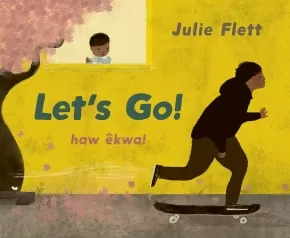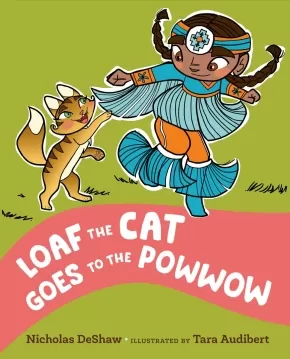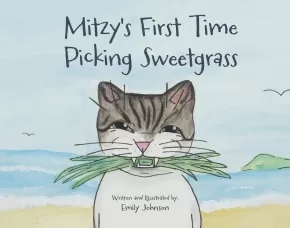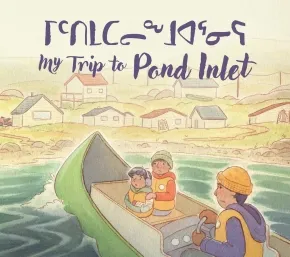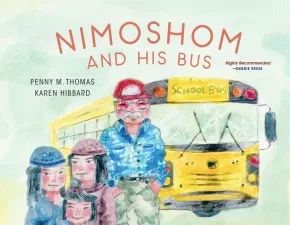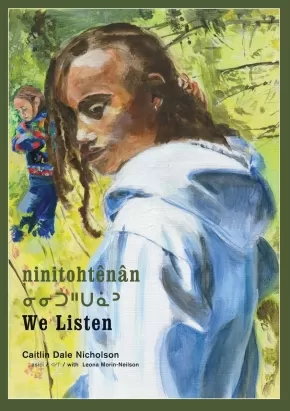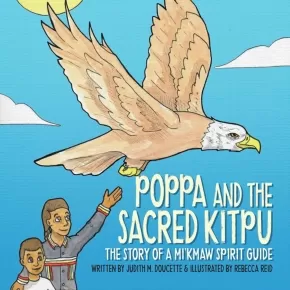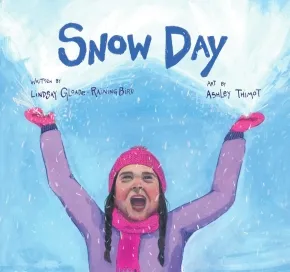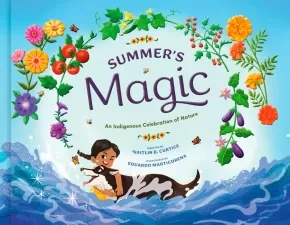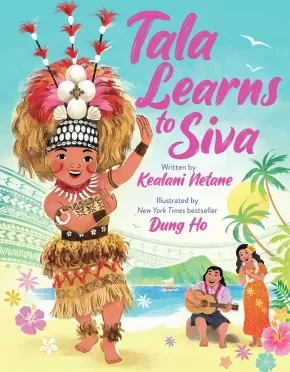
Picture Books
106
-
120
of
598 Results;
Sort By
Go To
of 40
Let's Go! haw êkwa
$23.95
Artists:
Format:
Hardcover
Text Content Territories:
Indigenous Canadian; First Nations; Cree (Nehiyawak);
ISBN / Barcode: 9781771646109
Synopsis:
Synopsis:
An extraordinary book that celebrates skateboarding, family, and community, from beloved artist and author Julie Flett, a winner of the New York Times / New York Public Library Best Illustrated Children’s Book Award.
Every day, a little boy watches kids pass by on skateboards, and dreams of joining them. One day, his mother brings a surprise: her old skateboard, just for him! haw êkwa! Let’s go! Together, they practice on the sidewalk, at the park, in Auntie’s yard—everywhere. But when it comes time to try the skatepark, the skateboarders crash down like a waterfall. Can he find the confidence to join them?
Let’s Go! features:
- A glossary of Cree words featured in the book, and a Cree refrain (haw êkwa!) repeated throughout
- A note to the reader from Julie Flett about her inspiration for the story
This fun and touching story is a tribute to family, friendship, and perseverance. Julie Flett’s renowned art and powerful text shows a community of support is all around, ready to help each other… go!
Reviews
“Beautifully highlights the value of perseverance along with the joy of skateboarding.”—Horn Book, STARRED Review
“Extraordinary…. A fun read from start to finish, "Let's Go!" is especially and unreservedly recommended as a choice pick for family, daycare center, preschool, elementary school, and community library Self-Esteem and Family Life picture book collections for ages 3-8.”—Midwest Book Review
“Masterful, simple, powerful….a must-read for anyone who skateboards or wants to — or doesn’t.”—Amina Chaudri, Booklist
“Using onomatopoeic language to capture the sounds of the sport, Cree-Métis creator Flett (We All Play) shows the hard work and investment of time that goes into both learning a new skill and becoming ‘a part of something—/ and myself.’”—Publishers Weekly, STARRED review
Educator Information
Recommended for ages 3 to 8.
Curriculum Connections: Sports / Indigenous Languages / Community / Goal-Setting / Risk-Taking / Self-Awareness / Self-Confidence
This book is available in French: On y va!
Recommended in the Indigenous Books for Schools catalogue as a valuable resource for English Language Arts, Art, and Physical and Health Education in kindergarten to grade 3.
Additional Information
44 pages | 11.00" x 9.00" | Hardcover
Loaf the Cat Goes to the Powwow
$24.99
Format:
Hardcover
Text Content Territories:
Indigenous American; Native American; Anishinaabeg;
ISBN / Barcode: 9780593461853
Synopsis:
Synopsis:
A Native American boy's cat surprises him at his first powwow—making for a very special dance indeed!
Loaf the cat loves to play with her boy, and when she’s particularly happy, she’ll make the purr sound for him. She also likes to keep tabs on him, so when he disappears one day, she decides to find him. She follows his smell to a place where there are drums and colors and lots of people—and then she’s excited to see her boy dancing fast, making the ribbons on his regalia twirl beautifully! When he takes a break, Loaf goes to greet him in her special way, making the powwow one her boy will never forget, and worthy of many purrs!
Reviews
“Loaf, a feline protagonist, follows her Ojibwe-cued caretaker, Charlie, to a powwow in this simply told picture book. Fond of rubber bands, paper bags, and ribbon, Loaf takes note when ‘my boy started putting all these ribbons on his clothes.’ . . . In an animated picture book debut, Anishinaabe author DeShaw walks readers through the powwow’s Grand Entry, told through the perspective of Loaf the cat. . . . Audibert (the Jo Jo Makoons series), of Wolastoqiyik and French heritage, aptly capture the energy of a cat at play and a boy taking part in the powwow—and the two displaying affection for each other.” —Publishers Weekly
Educator Information
Recommended for ages 3 to 7.
Additional Information
32 pages | 8.44" x 10.25" | Hardcover
Metis Like Me
$24.99
Artists:
Format:
Hardcover
Text Content Territories:
Indigenous Canadian; Métis;
ISBN / Barcode: 9781774881125
Synopsis:
Synopsis:
Whether or not you're Métis, there's so much to experience and learn about this amazing Indigenous culture — take a picture book journey into Métis crafts, music and cooking with friends who love to share.
Are you Métis like me? A group of children of Métis descent share and explore all the ways they celebrate and experience their heritage — enjoying traditional foods like bannock bread and Saskatoon berries; crafting with beads; sharing stories, dance, music and songs. Each child shares a different way they enjoy honoring their backgrounds and weaving parts of the rich tapestry that makes up Métis culture. One child, though, has grown up disconnected from their history, and can't join in with the others in the same way. But they soon see it's never too late to learn, celebrate or become a part of a community in which Métis and non-Métis alike can discover the richness of an often-overlooked culture.
This rhythmic, jubilant book will encourage young readers of all backgrounds to celebrate their own heritage and learn more about Métis history, and contains back matter including an author's note, recipe and dictionary to further inspire.
Educator Information
Recommended for ages 3 to 7.
This book is available in French: Nous sommes Métis.
Additional Information
40 pages | 9.43" x 9.31" | Hardcover
Mitzy's First Time Picking Sweetgrass
$14.95
Artists:
Format:
Paperback
Text Content Territories:
Indigenous Canadian;
ISBN / Barcode: 9781777854287
Synopsis:
Synopsis:
This book is about a curious kitty who gets to experience her first time sweetgrass picking with her mom.
Educator Information
Recommended for ages 4 to 6.
Additional Information
28 pages | 9.25" x 7.28" | Paperback
My Trip to Pond Inlet
$16.95
Artists:
Format:
Paperback
Text Content Territories:
Indigenous Canadian; Inuit;
ISBN / Barcode: 9781774507728
Synopsis:
Synopsis:
One rainy day, Solomon is playing inside with his sister. Their mom is cooking polar bear meat in a big pot of water. Suddenly, he trips and burns his arm in the pot of boiling water! The burn is so bad that he must travel to the health centre in the neighbouring community of Pond Inlet. Solomon has to stay in Pond Inlet until his arm heals. Even though Solomon misses his home, he likes playing with the other kids at the health centre and exploring the new and exciting community of Pond Inlet.
Educator & Series Information
Recommended for ages 5 to 7.
In My Trip to Pond Inlet children learn about the responsibility of being safe around hot water and taking care of themselves after an injury.
Dual-Language: English and Inuktitut
This book is part of the Community Connections series.
Additional Information
40 pages | 9.00" x 10.00" | Paperback
Nimoshom and His Bus (PB)
$14.00
Artists:
Format:
Paperback
Text Content Territories:
Indigenous Canadian; First Nations; Cree (Nehiyawak);
Grade Levels: Preschool; Kindergarten;
ISBN / Barcode: 9781774921166
Synopsis:
Synopsis:
In this warm and joyful picture book highly recommended by Debbie Reese, children learn Cree from Nimoshom, their school bus driver.
Based on the author’s memories of her grandfather, Nimoshom is not your average bus driver. He loves to drive the school bus, tell silly stories, and share his language with the kids who ride his bus.
Nimoshom and His Bus introduces readers to common Cree words and phrases alongside the common childhood experience of riding the school bus. A Cree word list is included in the back of the book.
Reviews
"Through accessible language and engaging visual resources, readers are introduced to basic Cree as Nimoshom responds in this language to the children who ride his bus.... The illustrator’s varying the visuals between full double spreads and single page illustrations keeps the pacing lively. Amidst a rural fall setting, with woodland animals, children, and the school bus, Nimoshom’s humorous nature shines through these gentle illustrations. At the end of this story, you just want to give Nimoshom a great big hug!"— Anita Miettunen, CM: Canadian Review of Materials
"In this bilingual book, readers follow a bus driver picking up kids and dropping them off before and after school. Like the students on the bus, readers quickly learn that the driver's native language is Cree, and he often speaks to them in his native language. Readers learn that "Nimoshom" means "my grandfather" and that "Ekosani" means thank you" as the author (of Cree descent herself) weaves Cree words into the text, and each new spread almost feels like a gentle wave: yes, we're subtly learning new words, but it never feels strenuous or forced, rather it's calm and poetic."— Let's Talk Picture Books
"While Penny M. Thomas' story is not a plot-driven allegory or a message-based lesson, Nimoshom and His Bus is a sweet introduction to some simple Cree words in the context of a common-place activity for many children.... Karen Hibbard who uses watercolours and pastels to create a gentle background for Nimoshom's day on his bus gives the story a grassroots mood, highly appropriate for a routine day of activity and interaction for this bus driver and his charges. It's very relatable."— Helen Kubiw, CanLit for Little Canadians
"If you're a regular reader of AICL, you know that we're always delighted by books by Native writers--especially ones set in the present. Books like Nimoshom and His Bus provide Native children with mirrors that non-Native children find in abundance.... I highly recommend Nimoshom and His Bus! It'd be a simple thing to use other Native words in addition to--or instead of--the Cree words in the book."— Debbie Reese, American Indians in Children's Literature
Educator Information
Recommended for ages 3 to 5.
Additional Information
24 pages | 9.50" x 7.50" | Paperback
ninitohtênân / We Listen
$21.99
Artists:
Format:
Hardcover
Text Content Territories:
Indigenous Canadian; First Nations; Cree (Nehiyawak);
ISBN / Barcode: 9781773068596
Synopsis:
Synopsis:
The third book in the Nôhkom series, in Cree and English, tells a story about gathering leaves for Labrador tea, while listening in different ways.
A child, her family and her friend have arrived at their favorite picnic spot by the lake, but before they eat lunch Nôhkom suggests they pick leaves for Labrador tea. Once among the trees, Nôhkom pauses for a moment to listen, and the others do too. Nôhkom prays, the girls take their turn, then Nôhkom shows them where to find the leaves. Nôhkom and Mom rest after harvesting, but the girls opt for a swim in the lake ... though they're quite happy to warm up afterwards with freshly brewed Labrador tea. And when it's time for the picnic, the girls take another turn at listening.
Beautifully rendered paintings in acrylic on canvas show the family outing. Includes a recipe for Labrador tea as well as a salve made from Labrador Tea leaves.
Educator Information
Recommended Ages: 3 to 7.
Written in short sentences in Cree and English (with Cree text appearing in standard roman orthography and syllabics), the book is a good choice for beginning readers and/or language learners.
This book is the third book in the Nôhkom series.
The story features different forms of listening — in the bush, to teachings from Nôhkom, to the conversation of family and friends (when listening can be especially fun!).
Key Text Features
illustrations
recipe
informational note
Correlates to the Common Core State Standards in English Language Arts:
CCSS.ELA-LITERACY.RL.1.2
Retell stories, including key details, and demonstrate understanding of their central message or lesson.
CCSS.ELA-LITERACY.RL.1.7
Use illustrations and details in a story to describe its characters, setting, or events.
Authenticity Note: Translator Leona Morin-Neilson is the inspiration for the stories and art in the Nôhkom series, which highlights her traditional knowledge of the uses of wild plants. She collaborated with the author to create this work and translated it into Cree.
Because of the collaboration between Leona and the author, and Leona's Cree translation, this book has been labelled as containing Authentic Indigenous Text. It is up to readers to determine if this work is authentic for their purposes.
Additional Information
24 pages | 8.50" x 12.25" | Hardcover
Poppa and the Sacred Kitpu
$18.95
Artists:
Format:
Paperback
Text Content Territories:
Indigenous Canadian; First Nations; Mi'kmaq;
ISBN / Barcode: 9781774571859
Synopsis:
Synopsis:
After being invited into his grandson’s school to share his wisdom and knowledge of his traditional Mi’kmaw culture in Poppa and His Drum, Poppa is happy to return as a respected Indigenous Elder and Knowledge Keeper.
In this second book of the Poppa series, we find Poppa giving his next gin’masuti (lesson in our culture) to his grandson, François, and his friends, Paul and Joe.
The boys have an important art project to complete for school and are not sure what to do. While spending the afternoon on a beach adventure with Poppa, the boys get to learn about the Sacred Kitpu (Bald Eagle) and why it’s so important to our Indigenous People.
Poppa engages the children with eager imaginations of how the Sacred Kitpu is not only a powerful spirit guide, but also represents the Spirit of the Creator among us. It is the messenger between Mother Earth and the Spirit World, whispering to the Creator our prayers, touching the face of the Creator with its wing.
Poppa teaches the children through mystic wonder how we use the Sacred Kitpu feather in many different cultural ceremonies. He embraces their eagerness to learn and shares the tradition of smudging, using the Kitpu feather along with Sacred Medicines that burn in a smudge bowl to purify our body, mind, and spirit.
The children delight in discovering Poppa’s never-spoken-of regalia treasures that once belonged to his grandfather and decide to commemorate their art project to the Sacred Kitpu.
Poppa is invited back to the class to award the winning medal to the winners of the arts project. He is proud to present the medals to happy children who truly understand and appreciate the importance of the role the Sacred Kitpu plays in our Mi’kmaw culture and heritage. Poppa and the Sacred Kitpu will delight and surprise the reader with fun and teachings given by the love of a Poppa who is cherished by his community for being such a wonderful Mi’kmaw Elder.
Educator & Series Information
Recommended for ages 5 to 12.
This book is the second book in the Poppa series, following Poppa and His Drum.
Additional Information
9.00" x 9.00" | Paperback
Sanirajak, A Place I Love
$16.95
Artists:
Format:
Paperback
Text Content Territories:
Indigenous Canadian; Inuit;
ISBN / Barcode: 9781774507704
Synopsis:
Synopsis:
Alice loves her community, and she's excited to show others her favourite things to see and do throughout the year. From ice fishing to collecting clams to cheering on hunters in the community, there is always something to enjoy in Sanirajak.
Educator & Series Information
Recommended for ages 5 to 7.
Dual-Language: English and Inuktitut
Readers will learn about different activities people do in each season in Sanirajak, Nunavut in Sanirajak, a Place I Love.
Sanirajak, a Place I Love teaches about the values of community and sharing food with community members after a hunt.
This book is part of the Community Connections series.
Additional Information
36 pages | 9.00" x 10.00" | Paperback
Snow Day
$24.95
Artists:
Format:
Hardcover
Text Content Territories:
Indigenous Canadian;
ISBN / Barcode: 9781774713112
Synopsis:
Synopsis:
A joyful, rhyming story in the vein of Ezra Jack Keats's The Snowy Day, this debut children's picture book follows an Indigenous family as they enjoy the magic of a winter storm.
All is quiet on the snow-laden street.
Not a single soul makes a teeny-tiny peep.
Then,
With a bound and a bang and a funny kind of twirl
Out comes a bundled-up joyful little girl.
Capturing the magic of a snowfall, Snow Day follows an Indigenous family as they experience all of the delights of a winter's day. While Mom shovels the driveway and Dad cares for her brother by the fire, a young girl and her dog make snowflake tea, build a snow caterpillar, catch snowflakes on their tongues, and make snow angels. All while the snow continues to fall. At the end of the day, the girl is beckoned inside by the promise of hot chocolate, and regails her family with her adventures' and dreams of doing it all again tomorrow.
Atmospheric, nostalgic, and full of winter fun, the debut picture book by mixed-Cree journalist, book reviewer, and podcast host Lindsay Gloade-Raining Bird is a celebration of Indigenous joy and childhood wonder. Features warm, colourful artwork rendered in traditional gouache and coloured pencil from debut illustrator Ashley Thimot.
Educator Information
Recommended for ages 3 to 7.
Additional Information
32 pages | 10.00" x 9.00" | Hardcover
Sometimes I Feel Like an Oak
$19.99
Artists:
Format:
Hardcover
Text Content Territories:
Indigenous Canadian; First Nations; Anishinaabeg; Algonquin;
ISBN / Barcode: 9781773066981
Synopsis:
Synopsis:
Following the success of Sometimes I Feel Like a Fox and Sometimes I Feel Like a River, this companion book explores the nature and beauty of trees.
Twelve lyrical poems look at twelve different trees, from early spring to deep winter. In each poem, a child identifies with a feature of the tree - such as the smooth trunk of a birch whose bark has peeled away, the strong branches of a spruce that shelter small birds or the pink flowers of a cherry blossom that tumble like confetti. The poems provide an opportunity to learn about each tree, inspiring us to look afresh at the trees around us - whether in the schoolyard, neighborhood or park - and get to know them better.
Danielle Daniel's passion for trees is beautifully matched by Jackie Traverse's paintings, which bring each tree to life. In the pages following the poems, children are invited to consider what different kinds of trees might mean to them. In an author's note, Danielle Daniel shares her belief, similar to her Algonquin ancestors', that trees are sentient beings with much to give and teach us.
Educator & Series Information
Recommended for ages 3 to 6.
This book is part of the Sometimes I Feel Like series.
This book encourages a familiarity with, knowledge about, love of and respect for trees, providers of shade, beauty, oxygen, medicines, food and more.
The text and illustrations show twelve trees from spring through winter, making this a title that could support teaching science units on the seasons.
Key Text Features
illustrations
author's note
poems
Correlates to the Common Core States Standards in English Language Arts:
CCSS.ELA-LITERACY.RL.K.5
Recognize common types of texts (e.g., storybooks, poems).
CCSS.ELA-LITERACY.RL.K.6
With prompting and support, name the author and illustrator of a story and define the role of each in telling the story.
CCSS.ELA-LITERACY.RL.1.4
Identify words and phrases in stories or poems that suggest feelings or appeal to the senses.
Additional Information
32 pages | 8.25" x 10.00" | Hardcover
Stitches of Tradition (Gashkigwaaso Tradition)
$24.99
Format:
Hardcover
ISBN / Barcode: 9780063218680
Synopsis:
Synopsis:
“Noozhishenh, bimadiziwin,” Nookomis says. “My granddaughter, live a good life.”
An Ojibwe grandmother carefully measures and selects just the right colors of fabric, and her sewing machine hums whirr, whirr, whirr late into the night.
In the morning, her growing granddaughter has a beautiful new ribbon skirt to wear, a reminder of her nookomis and the cultural traditions that stitch together her family with love.
This heartwarming story by Marcie Rendon (Ojibwe), with stunning illustrations by Joshua Mangeshig Pawis-Steckley (Ojibwe), celebrates the power of Indigenous craft and community and weaves together the spirit of resilience, female empowerment, and gratitude for the generations that came before us.
Reviews
A radiant and joyful glimpse at an important Native tradition." — Kirkus Reviews (starred review)
"Tradition and love are the core of this picture book...Ojibwe language is seamlessly woven into the dialogue. The digital art fully saturates the pages, layering textures and colors much like the ribbon skirts, and the palette is buoyant and bright, exuding a celebratory feel." — Bulletin of the Center for Children’s Book"s
Educator Information
Recommended for ages 4 to 8.
Detailed text perfect for read-alouds.
Backmatter includes a glossary of Ojibwa terms, more information on ribbon skirts, including history and significance, and infromation about manoomin (wild rice).
Additional Information
40 pages | 8.50" x 11.00" | Hardcover
Summer's Magic
$19.99
Artists:
Format:
Hardcover
Text Content Territories:
Indigenous American; Native American; Anishinaabeg; Potawatomi;
ISBN / Barcode: 9780593577837
Synopsis:
Synopsis:
An Indigenous boy invites new friends to share in beloved traditions as he celebrates the joy of summer and his love for Earth and Creator in this picture book that revels in the warmth, light, and fun of the longest days of the year.
Bo, a proud Potawatomi boy, is excited to enjoy long summer days tending his garden, walking his dog, and playing in the river with his big sister, Dani. When he discovers that his family's favorite spot has been polluted with garbage, Bo realizes that caring for Earth is part of what makes summer special. And when he overcomes his shyness and invites others to join in, he discovers that summer's magic has even more surprises in store.
“Bo is short for saying Bodewadmi ndaw, which is ‘I am Potawatomi’ in our language. Bo is a celebration of Anishinaabe culture, from the way he wears his hair in a traditional braid to the way he shares the magic of summer and honors Earth by caring for her as she cares for us.”—Kaitlin B. Curtice
Educator & Series Information
Recommended for ages 3 to 7.
This book is part of the An Indigenous Celebration of Nature series.
Additional Information
40 pages | 11.00" x 8.50" | Hardcover
Tala Learns to Siva
$25.99
Artists:
● Dung Ho
Format:
Hardcover
ISBN / Barcode: 9781338859317
Synopsis:
Synopsis:
A lovingly empowering story about finding courage and strength in your family, history, and community through a traditional and cherished Samoan dance, taualuga. Written by debut author, Kealani Netane, and illustrated by New York Times bestselling illustrator, Dung Ho.
Tala wishes that she could dance the traditional Samoan dance, the taualuga, just like her Aunty Sina. But Tala's legs are too bouncy, her arms are too stiff, and she doesn't have Aunty's 'glow' when she dances. When Tala prepares to perform at her Grandma's birthday, she freezes on the stage. Will she find the strength and inspiration to help her dance?
Newcomer Kealani Netane crafts a heartwarming story about finding your inner strength through the love and guidance of your family. New York Times best-selling illustrator Dung Ho's cheerful colors and sweet characters bring this loving story to life, making this the perfect gift for little ones who are learning how to follow their hearts and make their own paths.
Reviews
"Netane’s debut celebrates individual perseverance and connection to Samoan culture as a girl, Tala, learns to siva from her heart." -- Publishers Weekly
Educator Information
Recommended for ages 4 to 8.
Additional Information
32 pages | 8.50" x 11.00" | Hardcover
Teachings of the Drum
$12.95
Format:
Hardcover
Text Content Territories:
Indigenous Canadian; First Nations; Nuu-chah-nulth (Nootka);
ISBN / Barcode: 9781778540387
Synopsis:
Synopsis:
The drum is a special symbol in many Indigenous cultures. In this rhyming picture book, young Ren is given a handmade drum by his mother that help to teach him many things about himself and his culture.
An adaptation of the best-selling book, Drum from the Heart, by Indigenous author Ren Louie for ages 4-6.
Educator Information
Recommended for ages 4 to 6.
This book is an adaptation of Drum from the Heart for ages 4 to 6.
This book is available in French: Les enseignements du tambour
Additional Information
24 pages | 8.50" x 7.50" | Hardcover
Sort By
Go To
of 40

